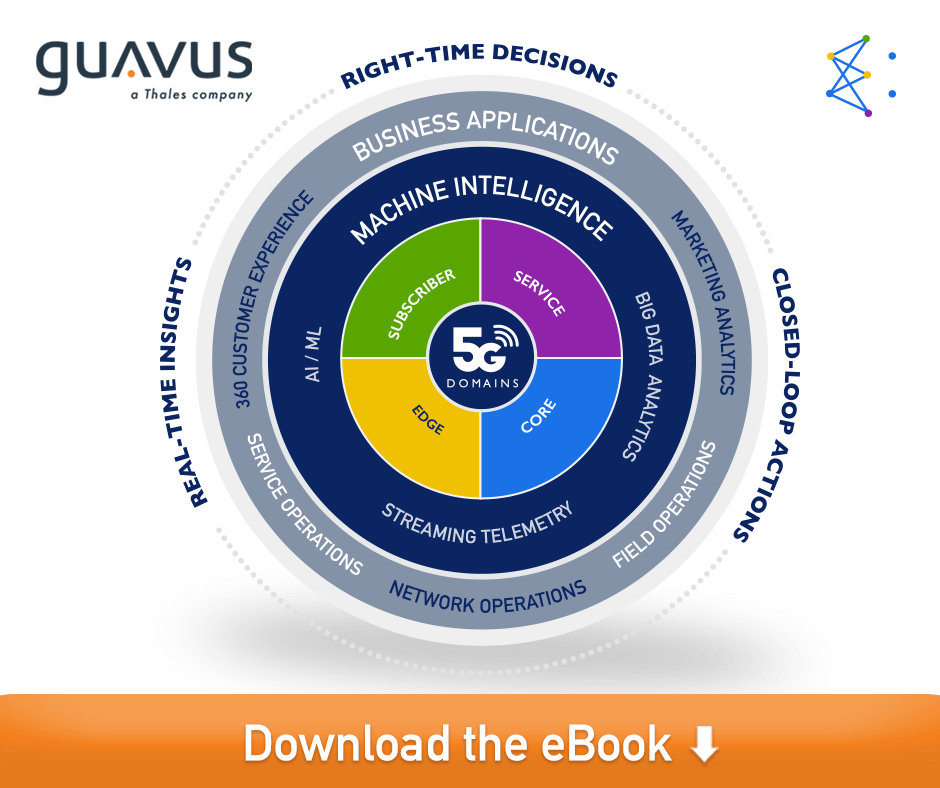Superior customer experience: Automating 5G networks & services with AI-powered analytics
The arrival of 5G offers significant benefits to consumers and businesses. There are new possibilities for AR and VR (augmented and virtual reality), smart cities, factory automation, remote operation, intelligent transportation, smart grids, sensors, logistics and offices, and connected homes. The low latencies and high data throughput metrics offer possibilities that, at this relatively early stage, have still yet to be fully realized.
For CSPs (communications service providers) the practicalities and pain-points center around two facts: the data throughputs across all areas of the network will rise significantly as device numbers (and capabilities) increase, and the new services will mean that there will be new areas of competition with which to contend. Expectations of performance, security and service reliability will be high, and what’s more, with more areas of technology and different industry verticals deploying new technologies (next-gen industrial internet of things {IIoT}, smart technologies, embedded systems and so on), there will be further sources of business-critical data to manage.
CSPs will be able to differentiate themselves from competitors in each of the domains in which 5G will be deployed: subscriber, service, and network edge and core. In each domain, aggregating and analyzing the huge influxes of data in real-time in order to ensure the highest levels of service will become essential; current technologies simply will not be able to cope, nor create insight of the required standard.
Competition is always fierce among CSPs, especially in terms of pricing, in which the most sensitive influence is service cost. Drawing insight from big data is clearly desirable, but the cost of doing so might potentially be high. But by using machine intelligence to draw out the gems (and trends), companies will be able to create true 360-degree customer experiences and find different market opportunities.
Artificial intelligence for CSPs
Every product under the sun seems to boast its artificial intelligence (AI) capabilities: phone cameras, refrigerators, traffic management systems, and so on. It’s easy to get confused by the difference between cognitive algorithms, machine learning, deep learning, and the different variations. The key aspect to remember is the ability of a system to alter itself according to the data processed, in a continuous process. That’s the “learning” part of machine learning.
That malleability is especially important for CSPs of any flavor, as network conditions can change rapidly due to multiple factors. Furthermore, those changes may only last a few minutes but have a significant impact on the users’ experiences.
Complex network variables
If we consider the real-time metrics at CSPs’ disposal, the data is both massive, and massively varied. New techniques in signal modulation and transmission have made networks more efficient and capable of multigigabit throughput. As small cells proliferate, and vendors take advantage of IIoT (to take a single example), there will also be huge variances in the peaks and troughs of data use patterns. Influences include user behavior, different applications, servers, customer-premises equipment (CPE) metrics, location, local events and news, media releases, traffic surges, and so forth.
AI is the only way that CSPs can react and respond fast enough in the face of this flood of data. A large business conference may generate a spike in use of video streams by the attendees and organizers, and smart AI could address this situation in real-time before any single user notices an issue: that’s indicative of the potential of AI, especially when CSPs consider the possibilities of machines learning about similar events, and preparing proactively.
Competitive 5G (and 4G, 3G, 2G…)
Smart systems aren’t just about managing peaks and troughs of demand. Use of advanced analytics solutions powered by AI and machine learning (ML) and specifically designed for CSPs (from Guavus) has meant that subscriber bases can grow quickly, reaching the level of hundreds of million users in record time. As well as developing prospects with AI/ML-driven analytics, the technology opens up new cross- and up-selling opportunities to existing customers. What follows too from AI, is the ability to reduce costs that can be passed onto customers.
Proactive network management by AI-powered analytics and automation solutions may seem to be an esoteric technology use-case, but machine learning solutions are able to monitor and react according to patterns they’ve observed, in real time. That boosts the quality of user experience as you might expect, creating a new breed of customer experiences that will ensure loyalty to the brand. And with fewer problems, there will be fewer contacts with expensive, human-staffed call centers to fund, and certainly less of an impetus for lucrative contracts to be switched to a competitor.
Artificial intelligence in customer care
The significant fact about data is that it’s just a series of zeroes and ones. For customer care that means that, with the correct technology, insightful information can be drawn in real time and even reacted to by AI/ML-based analytics, presenting the right messages to the right people at the right time, in the target’s preferred channel and format.
Harnessing AI for CSPs needs specific vendors with the industry knowledge and positioning to be able to bring relevant solutions to the table. That’s why here at TechHQ we’re fascinated with the way that Guavus is transcending the marketing hype that puts the AI stamp on too many products.
For CSPs, organizations that are at the cutting edge of 5G technology with all its possibilities, it is refreshing to find a company that offers practical, demonstrable business-oriented use of very advanced technology. To download an informative eBook about 5G, AI and advanced analytics, click here. We hope you are as excited by the future of the mobile, 5G-powered space as we are.










